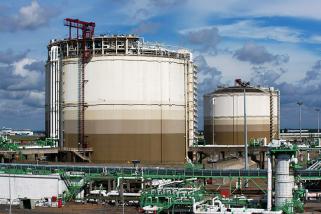 What is the environmental footprint of an LNG onshore storage built with GST® membrane technology? How does it compare to the Full Containment 9%Ni technology, widely used in the industry?
What is the environmental footprint of an LNG onshore storage built with GST® membrane technology? How does it compare to the Full Containment 9%Ni technology, widely used in the industry?
With the current emphasis on decreasing CO2 emissions, governments and financial institutions incite developers of LNG import and export projects to find solutions to minimise the carbon footprint. As a result, more and more players in the industry inquire us about the environmental performance of our technologies, as the carbon footprint has become a key indicator in the investment decision-making process.
GTT has therefore worked with ‘RDC Environment’, an expert of environmental impact assessment, to calculate the environmental footprint of our GST® tank solution used for LNG onshore storage.
This is the first study on LNG land storage assessing the full potential environmental impact, including not only greenhouse gas emissions, but also other environmental impacts such as acidification, particle emission, resource depletion, etc.
This article unveils the results of this extensive analysis. This study has used EU standard as reference and enables the comparison with other storage technologies.
The main outcome of the study is that GST technology improves the global environmental impact by 23%, and more specifically the CO2 emissions by 16% compared to the Full Containment 9%Ni technology.
The strength of this study is that it covers the entire life cycle: from the “cradle to the grave”. This avoids potential bias that could arise if only focusing on the final assembly of the tank, without including the raw materials, their extraction, transformation, transport but also the end of life such as the dismantling and recycling of the tank.
The study is based on figures referring to an LNG onshore tank of 220,000 m3 considering a building location in China. Similar characteristics such as storage volume, performance (Boil of Rate), etc. are used for the different tank technologies for a fair comparison. The scope of the study includes the external structure (the concrete) and the tank containment system (insulation, etc.).
The environmental footprint can be analysed through various angles. To begin with, we can consider what is called the “Global Environmental Impact Value”. It is the combination of 16 environmental aspects such as Climate Change (kg CO2 equivalent), Fossil Resources Used (MJ), Particulate Matter emissions, acidification (mole H+ equivalent), water used (m3 world equivalent), mineral and metal resource depletion and many others.
The 16 sub factors are aggregated to establish a global value expressed in “Average World Citizen Equivalent Unit”. This is a representative unit defined by the JRC (Joint Research Center), an organisation providing scientific support to the European Commission on the environmental impact evaluation. To obtain such a unit, normalisation and weighting factors are used. The one considered comes from the standard JRC recommendation (EF v2.0).
The Global Environmental Impact Value of a 220,000 m3 LNG onshore tank built with the GST® technology is 2029 Average World Citizen Equivalent Units. The same tank, built with the Full Containment 9%Ni technology, has a global environmental impact of 2636 Average World Citizen Equivalent Units. This means a 23% improvement when switching from Full Containment 9%Ni to GST® technology.
Global reading values are interesting but not so tangible, so to go further into details, we propose to focus on the two main influencing parameters which are the Climate Change (CO2 equivalent emission) and the Fossil Resources used (Mega Joule).
This shows that the GST® tank improves the Climate Change impact by 16% compared to the Full Containment 9%Ni tank (including the CO2 emission and CO2 saving from recycling process).
When looking at the Fossil Resources used, the study shows that the GST® tank reduces the energy consumption by 11% compared to the Full Containment 9%Ni tank (including the energy used and energy saving by reuse of the dismounted material).
The main differences between the GST® technology and the Full Containment 9%Ni technology are due to the “in tank metal material”, which significantly impacts the CO2 emissions, the energy consumption and the acidification. The explanation is that the GST® technology relies on a metallic membrane, so a small amount of cryogenic metal is used in the tank, whereas the Full Containment 9%Ni tanks use a much thicker amount of steel.
Indeed, the Full Containment 9%Ni tanks use 4 times more steel, which means about 3 000 tons of steel for a 220,000 m3 tank. So, even if a high level of recycling of the steel has been considered (95%), the production and treatment of this steel material is affecting significantly the environmental footprint of the Full Containment 9%Ni technology.
Whatever the angle of analysis, be it global, such as the Global Environmental Impact Value, or more specific, such as Climate Change, Resource use, Acidification or Particulate Matter, the outcome remains the same: there is a significant improvement of the environmental footprint when switching from Full Containment 9%Ni to GST® technology.
GTT will continue to concentrate on the environmental factor in its future developments and improve them in order to meet its objective of developing technologies for a sustainable world.


